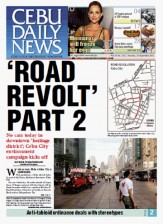
Only pedestrians will be allowed today in part of the Parian district of downtown Cebu City.
For one whole day, the entire stretch of Lopez Jaena, P. Burgos and part of Colon Streets will be closed to motor vehicles in a reprise of the June 12 Road Revolution,which shut out traffic on Osmeña Boulevard on Independence Day.
“We will once again transform the roads into a park for a day,” said Vince Cinches, a green activist in a campaign of pro-environment advocates seeking to reform road design and lessen the dependence on fuel-burning cars.
“It will be a day where the public can freely use the roads for running, walking, cycling or skateboarding. We will even do planking,” said Cinches, 350.org country coordinator.
Detour routes were announced yesterday by the Cebu City Traffic Operations Management (Citom) in a press conference.
With less than a day’s notice to the public, however, the sudden change in jeepney routes and vehicle access is expected to spark complaints from commuters.
An additional 40 traffic enforcers will be fielded to guide motorists, said Citom traffic aide Ulysses Empic.
He said commuters should be prepared for longer travel on the road because of the change in directions.
This time, men and women in Filipiniana dress will parade the streets, which fall in the “heritage district” of the city, where several churches, museums and landmarks make this a favorite route for tourist guides.
Road Revolution organizers led by environmental lawyer Antonio Oposa Jr. said the whole-day activity would be a festive affair for families, with booths selling organic vegetables and artwork, and the streets wide open for cyclists and strollers.
The activity aims to “turn around” the public’s mind-set and “bias of roads for cars and motor vehicles” into a system that gives priority to people and non-polluting forms of transportation.
The movement’s motto is “Those who have less in wheels must have more in roads.”
Cinches, Oposa and architect Joy Onozawa explained in a press conference that the quality of urban life would be vastly improved if roads are more used by people than cars.
A pending proposal of the Road Revolution movement sent to City Hall seeks a redesign of the road system to devote 30 percent to sidewalks, 30 percent for bike lanes, 30 percent for a non-polluting transport system and 20 percent for gardens.
Today’s route in the old Parian area features the Basilica Minore del Sto. Niño, Heritage of Cebu sculptures, Cebu City Hall, Plaza Sugbo, Casa Gorordo, a Jesuit pre-war house and the Metropolitan Cathedral.
Only pedestrians and bicycles will be allowed in those areas.
The activity is also part of the Kabataan, Kultura, Kabilin (Culture, Youth and Heritage) program of the Ramon Aboitiz Foundation Inc. to awaken the citizenry’s sense of heritage and culture.
Artwork using recycled materials will be shown by volunteers from the United Nations Youth Association (UNYA)-7.
“We want to be role models for environmental awareness and protection. We will be showing a trisikad and kalesa artwork made of recycled bottles,” said Darwin Morano of UNYA-7.
The Road Revolution activity starts with a 6 a.m. Mass at the Basilica Minore del Sto. Niño celebrated by Augustinian priest Fr. Tito Soquiño.
At 9 a.m., Oposa will discuss the Road Revolution campaign at the audiovisual room of the Eduardo Aboitiz Study Center on Lopez Street across Casa Gorordo. A program will be held at Casa Gorordo and a culminating Mass at the basilica.
The first Road Revolution activity was held on June 12 in the 2.4-kilometer Osmeña Boulevard. The event was timed for Independence Day to mark “freedom from dependence on oil.”
Plans ahead include making certain roads exclusive for pedestrian every Sunday (“Domingo sa Sugbo”) and greening public lots in Cebu City, starting with yesterday’s planting of alugbati (Malabar spinach) in sidewalks of Veteran’s Drive in barangay Lahug.
A proposal on this has been sent to Cebu City Councilor Nida Cabrera.
For today, “We won’t allow any motor vehicles in the area,” said Citom chief Rafael Yap.
He said the road closure would be inconvenient for the riding public but that it’s already a familiar experience for many motorists since Colon Street is frequently closed for night markets.
“If there’s a minor disturbance, the benefit will be greater because this is for our environment,” Yap told Cebu Daily News.